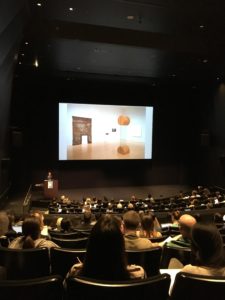Curator, researcher, producer and story-teller
Laura Belik on the Arts + Design Wednesdays @ BAMPFA | Curation Across Disciplines talk
Curating Charles Howard: A Margin of Chaos with Apsara DiQuinzio
 It is always a great pleasure to have the opportunity to participate in a lecture with a curator that has a show on view. This week’s “Curation Across Disciplines” talk with BAMPFA curator Apsara DiQuinzio gave an overview of the process of putting together the exhibition Charles Howard: A Margin of Chaos, currently on view at BAMPFA.
It is always a great pleasure to have the opportunity to participate in a lecture with a curator that has a show on view. This week’s “Curation Across Disciplines” talk with BAMPFA curator Apsara DiQuinzio gave an overview of the process of putting together the exhibition Charles Howard: A Margin of Chaos, currently on view at BAMPFA.
But after all, who was Charles Howard? This was the first question DiQuinzio shared with the audience. How do you come up with a theme for a show? How do you know if that topic is relevant enough to share with an audience? The work of a curator, at first, is very much an investigative one. DiQuinzio first came across the artist Charles Howard, noticing some of his work amongst other well-known artists in survey exhibitions in the U.S. and abroad in the mid-1920’s. Considered a surrealist and abstract painter, Howard somehow didn’t receive as much attention as some of his colleagues and personal friends did, such as Alexander Calder (1898- 1976). That was what first caught the attention of DiQuinzio, and what made her propose this show.
The process of curating always starts with research. One must deeply understand the historical aspects of that determinate subject, and to know if there are enough materials available to be shared with the public. Not only that, they have to make sure they can get other institutions to loan their works temporarily and if they have the rights to actually show that material. “It takes about two to three years to put together a show… and you usually start the conversation about it around five years prior,” the curator warns the audience. In contrast to writing a paper or an article, curating an exhibition is a complex process that involves various people along the way.
Regarding the Charles Howard show, there was a lot to be revealed. When there are limited writings or materials on a certain artist /author, the role of the curator almost becomes one of “history maker.” “Once you start digging into archival materials you are rigorous on your research. This is an opportunity for you to write the history & put together a research on the artist,” commented DiQuinzio.
 After the preliminary research phase, the curator moves on to production. From putting together the catalogue, photos, framing, shipping and the installation process, the curator also has to be in tune with their budget and how to raise funds. The checklist is directly connected to the costs of the show and to loaning processes. When creating an exhibition, one has to be aware that sometimes he/she will have to work according to what he/she managed to secure for that show.
After the preliminary research phase, the curator moves on to production. From putting together the catalogue, photos, framing, shipping and the installation process, the curator also has to be in tune with their budget and how to raise funds. The checklist is directly connected to the costs of the show and to loaning processes. When creating an exhibition, one has to be aware that sometimes he/she will have to work according to what he/she managed to secure for that show.
Despite the complexity of putting together an exhibition, the curator is ultimately telling the audience a story. Every story-teller gets to build their narrative the way they please. The Margin of Chaos, according to DiQuinzio, is the suspended zone that Howard gets to in his paintings. The name of the show is also playing with the idea of the unknown and the unreadable margins that need to be excavated. No story has an ending, but often stories offer different interpretations. It is now up to the audience to excavate Howard’s life and work from what has been revealed.
Lauren Belik (PhD Student, Architecture) reviewed the September 6, 2017 talk, Curating Charles Howard: A Margin of Chaos, with Apsara DiQuinzio. Curating Charles Howard was the second lecture in the Fall 2017Arts + Design Wednesdays @ BAMPFA series. To learn more about the series, see below:
What does it mean to curate? How has the role of the curator changed in our contemporary moment? Does the curator function differently in the performing arts, the visual arts, film, and in the fields of science and technology? And, how has curating changed as it responds to new forms of cultural and digital participation? When curation has become a popular metaphor in many domains –from food, to music, to social media — how do we define this expanded practice?
Co-taught by Shannon Jackson, Associate Vice Chancellor of the Arts + Design; Natasha Boas, independent curator, art historian and critic; and Eric Siegel, Director of the University of California Botanical Garden at Berkley, Arts + Design Wednesdays @ BAMPFA will explore this theme with some of the most innovative and incisive writers, artists and scholars of our time. Learn more here.
